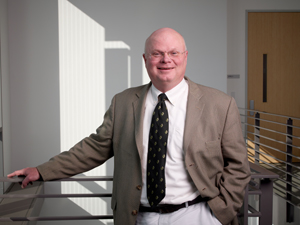Pegram to head Stanford breast cancer program.
Pegram to head Stanford breast cancer program

Mark Pegram arrived Feb. 1 and will head the breast oncology and molecular therapeutics programs.
Mark Pegram, MD, a renowned clinician and scholar in breast cancer research and a leader in translational medicine, has joined the Stanford University Medical Center to direct the breast oncology and molecular therapeutics programs. Pegram began his new position Feb. 1.
As part of the new Women’s Cancer Center clinic, which opened in June, Pegram will help bring newly developed breast cancer therapeutics to clinical trials, conduct his own research and treat patients. “Our goal is to improve our ability to extend the quality and quantity of life for breast cancer patients,” said Beverly Mitchell, MD, director of the Stanford Cancer Institute. “Mark is going to help accomplish this by bringing together excellent clinical care and new approaches to the diagnosis and treatment of breast cancer.”
“I watched him in his early career, and was really impressed with his humanity, compassion, scientific expertise and collaborative nature,” said Jonathan Berek, MD, director of the Stanford Women’s Cancer Center.
Pegram earned his medical degree from the University of North Carolina School of Medicine before joining the faculty of UCLA in 1993. He came to Stanford after serving at the University of Miami Miller School of Medicine, where he was a Sylvester Chair professor of medicine in the Braman Family Breast Cancer Institute, and associate director for clinical research in the UM Sylvester Comprehensive Cancer Center.
As a fellow in oncology at UCLA, Pegram helped to develop a breakthrough treatment for a deadly form of breast cancer. The treatment combines standard chemotherapies with trastuzumab (trade name Herceptin), a drug that targets the HER-2 cell-surface receptor. The HER-2 drives cell replication, and more than 20 percent of breast cancer patients have tumor cells that overproduce HER-2. In 2004, Pegram reported in the Journal of the National Cancer Institute that a new combination treatment selectively killed breast cancer cells that overproduced HER-2 in the laboratory. Pegram and others followed the study with clinical trials that showed Herceptin boosted survival rates and even cured some breast cancer patients.
“I was very impressed with his ability to translate laboratory discoveries into the clinic,” said Douglas Blayney, MD, medical director of the Stanford Cancer Institute, who also collaborated with Pegram on the study.
One of the strategies to make Stanford a premier cancer center is to increase the number of patients participating in translational clinical trials, said Blayney. The trials provide hope for patients who have exhausted standard treatments.
While at the University of Miami, Pegram continued to orchestrate high-quality clinical trials for experimental treatments. He was a senior author of a study demonstrating that combining a cell-signaling inhibitor, called lapatinib, with an estrogen blocker increases treatment success in patients with metastatic breast cancer.
In coming to Stanford, Pegram will continue forming bridges between scientists and clinicians to develop new treatment strategies.
“Cancer is an extremely complex condition. Every patient’s condition is unique. No one investigator or lab could come to terms with this high degree of complexity,” said Pegram. He noted that many faculty members already have experimental therapeutics, and one of his first agenda items is to help set up new trials.
“There’s a lot to be done in cancer research, particularly in women’s cancers,” said Pegram, “and Stanford is just the place to do it.”
By Beth Mole
Beth Mole is a science-writing intern in the Office of Communication & Public Affairs
###
* Stanford University Medical Center integrates research, medical education and patient care at its three institutions – Stanford University School of Medicine, Stanford Hospital & Clinics and Lucile Packard Children’s Hospital.
** The above story is adapted from materials provided by Stanford University School of Medicine
________________________________________________________________




















